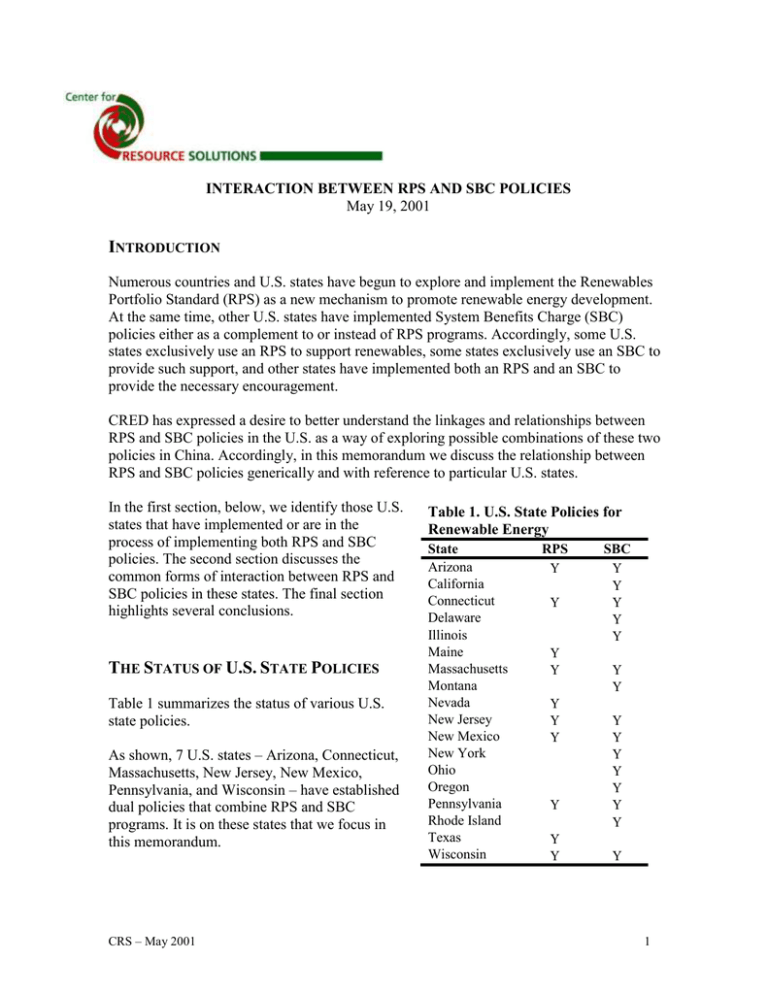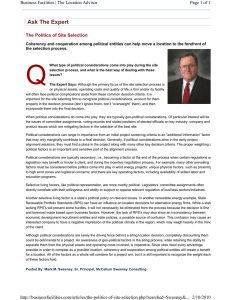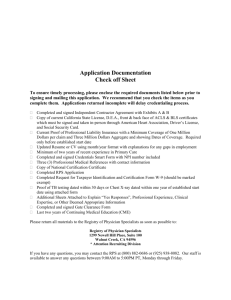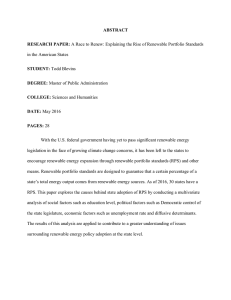I
advertisement

INTERACTION BETWEEN RPS AND SBC POLICIES May 19, 2001 INTRODUCTION Numerous countries and U.S. states have begun to explore and implement the Renewables Portfolio Standard (RPS) as a new mechanism to promote renewable energy development. At the same time, other U.S. states have implemented System Benefits Charge (SBC) policies either as a complement to or instead of RPS programs. Accordingly, some U.S. states exclusively use an RPS to support renewables, some states exclusively use an SBC to provide such support, and other states have implemented both an RPS and an SBC to provide the necessary encouragement. CRED has expressed a desire to better understand the linkages and relationships between RPS and SBC policies in the U.S. as a way of exploring possible combinations of these two policies in China. Accordingly, in this memorandum we discuss the relationship between RPS and SBC policies generically and with reference to particular U.S. states. In the first section, below, we identify those U.S. states that have implemented or are in the process of implementing both RPS and SBC policies. The second section discusses the common forms of interaction between RPS and SBC policies in these states. The final section highlights several conclusions. THE STATUS OF U.S. STATE POLICIES Table 1 summarizes the status of various U.S. state policies. As shown, 7 U.S. states – Arizona, Connecticut, Massachusetts, New Jersey, New Mexico, Pennsylvania, and Wisconsin – have established dual policies that combine RPS and SBC programs. It is on these states that we focus in this memorandum. CRS – May 2001 Table 1. U.S. State Policies for Renewable Energy State Arizona California Connecticut Delaware Illinois Maine Massachusetts Montana Nevada New Jersey New Mexico New York Ohio Oregon Pennsylvania Rhode Island Texas Wisconsin RPS SBC 1 COMMON RPS-SBC INTERACTIONS U.S. states have basically taken one of three approaches to designing the interaction between RPS and SBC policies. These are also the approaches that might be considered in China, to the extent that both RPS and SBC policies are established. Here we describe the various approaches and their relative merits. Approach 1 Target SBC Funds to Renewable Energy Projects and Programs that are Not Expected to Thrive Under an RPS This approach recognizes that despite its benefits, RPS policies cannot easily be designed in a way to eliminate the need for all other forms of renewable energy support. SBC programs may be a useful complement to RPS policies and can used to fund renewable technologies and programs that would otherwise not be supported by the RPS. The RPS will typically provide encouragement to renewable energy sources that are closest to cost parity with traditional forms of generation – this is the nature of competition that will be created among renewable projects to meet the purchase obligation. In the United States, for example, this means that wind power will benefit significantly from RPS policies. Unfortunately, because of this competitive dynamic, the RPS (as it is typically designed) is unlikely to: 1. Adequately support higher cost renewable energy resources. For example, solar photovoltauc power cannot compete with wind power on a cost basis at this time, and an RPS unless designed with a photovoltaics band or tier is unlikely to provide great support to these resources. 2. Adequately support renewable energy education, R&D, and infrastructure development. These programs will need other funding mechanisms. 3. Adequately support off-grid renewable energy systems, customer-sited renewable energy systems, or renewable energy systems that offset electricity usage (e.g., solar hot water, daylighting, etc.). To be sure, RPS programs can be designed to meet some of these needs. However, with every design tweak intended to expand the breadth of the policy, RPS programs become more and more administratively complex and costly. Recognizing this situation, a number of U.S. states have designed their RPS policies to support near-market renewable energy sources and have implemented SBC policies to fund programs that “fall through the cracks.” By way of example: Wisconsin’s SBC will focus on customer-sited renewable energy systems (PV, solar hot water, daylightling, digester gas, etc.) that are unlikely to find sufficient support under an RPS. New Mexico’s SBC is similarly focused, and has an emphasis on using renewable energy in public-sector buildings and schools. CRS – May 2001 2 New Jersey’s SBC administrator, meanwhile, has opted not to provide support to landfill gas generation because it is believed that landfill gas will do well under the State’s RPS policy. Other states have considered making renewable projects that receive SBC funds ineligible for meeting RPS obligations. Approach 2 Ignore Linkages between Policies and Operate RPS and SBC Programs in Parallel A second approach used in some states, and one that we do not recommend for use in China, is for RPS and SBC administrators to go about their respective businesses without seriously considering the appropriate linkages between the two policies. This is an approach apparently being taken or approximated in several U.S. states. The most tangible outcome of this approach is that SBC policies will end up supporting renewable energy projects that would otherwise have been developed under an RPS. Note that this is not the case under Approach 1, above, because Approach 1 implies that SBC funds are targeted to renewable energy projects and programs that would not be adequately supported by an RPS. Under Approach 2, meanwhile, both an RPS and SBC may simultaneously provide support to renewable energy projects that would have been developed under the RPS even without further financial support from SBC funds. This implies that either: 1. The existence of the SBC is reducing the cost of the RPS by “buying-down” the cost of renewable energy supply for electricity distributors who have an RPS purchase obligation. Or, 2. Renewable energy projects are receiving windfall profits by obtaining financial support from both RPS and SBC policies. We posit that neither of these outcomes is desired. The first outcome simply creates cost shifting between the RPS and SBC policies with no net benefit. The second outcome creates a situation where a country or state is paying too much for renewable energy in aggregate. Approach 3 Use an SBC to Recover the Cost of the RPS A final approach, used in only one U.S. state – Arizona – is to explicitly use the funds collected by an SBC to help offset the cost of the RPS for those electricity supply companies facing the RPS purchase obligation. Before describing this approach in Arizona, it is first useful to recognize that all RPS policies require some form of cost recovery. That is, the RPS will most likely require retail suppliers (on whom the RPS applies) to incur compliance costs. These costs, if prudently incurred, should be passed on to consumers. In most U.S. states, cost recovery is assured through one of two mechanisms: CRS – May 2001 3 1. 2. Competition. Where retail suppliers are able to freely establish their own retail rates, as is true under retail competition, the private market can be expected to pass on the costs of RPS compliance to end-use customers. Because retail competition does not exist in China at this time, this approach is not an option. Regulation. Where retail suppliers are not allowed to freely establish their own rates, as is true in China and many U.S. states, regulation must establish cost recovery principles. For example, in Wisconsin it is expected that RPS compliance costs will be passed on to consumers through higher rates, as established by the Public Utilities Commission. Similarly, in China under an RPS, government regulators will be required to establish retail electricity rates that allow suppliers to pass on their RPS compliance costs fairly to consumers. If such a passthrough is not allowed, political resistance towards the RPS will be severe. An alternative to the two more common approaches described above is to use an SBC to help fund the costs of the RPS. This approach has one critical advantage to the others listed above. Under an SBC, RPS compliance costs may be spread evenly (or as desired by policymakers) over all consumers in a jurisdiction. Under the other approaches, RPS compliance costs may unavoidably vary by region or electricity supplier (due to differential resource quality or contracting capabilities). Take a tangible example of China. If China had a national RPS of 5.5%, it can be expected that those regions with higher existing quantities of renewable energy and/or better resource quality would see lower compliance costs than those regions with low pre-existing levels of renewable energy and poor prospects for additional renewables capacity. Under the price regulation approach to cost pass-through, these differentials in cost would also result in higher consumer costs in some regions than others. With an SBC, established at a single uniform level across the entire nation at a level that is required to ensure cost passthrough, costs could be more evenly spread over the entire nation. Application of this approach is far from easy, however, and as mentioned above only one U.S. state has explored its use – Arizona. In Arizona, the cost of the RPS may be recovered through several means. First, part of the cost of compliance may be recovered by utilities through current SBC charges, including a reallocation of funds from their existing use energy efficiency funding. Second, a new Environmental Portfolio Surcharge may be applied by individual utilities, with caps on the surcharge level established by the Arizona Corporation Commission. The principal challenges in the application of this approach are twofold. First, it may be politically challenging in most circumstances to create consensus not only around an RPS but also an SBC funding mechanism. Perhaps even more difficult will be to maintain political momentum over time to keep the SBC intact to ensure cost recovery. Second, careful consideration must be given to the size and application of the SBC to ensure that all parties have appropriate incentives for cost minimization. Electric utilities should not automatically be allowed to pass on all RPS compliance costs through the SBC charge. CRS – May 2001 4 Instead, careful regulatory scrutiny on the prudence of each utilities’ RPS compliance costs should be required to ensure that all parties have the incentive to minimize costs. CONCLUSION In summary, we believe that Approaches 1 and 3, above, merit consideration, and we note that these two approaches are not mutually exclusive. That is, an SBC might be designed to be sizable enough to both: (1) recover the costs of RPS compliance, and (2) target renewable energy projects and programs not likely to significantly benefit from the RPS. We believe that Approach 1 is particularly important. While there are certainly other ways to cover the cost of RPS compliance (i.e., through standard tariff changes), approaches to support offgrid, customer sited, and higher cost but promising renewable energy technologies are limited. With respect to Approach 3, we also do re-emphasize the political and practical complexities that may arise to make this use of SBC funds unmanageable. Of course, it could be argued that all forms of RPS cost recovery will face similarly daunting challenges. CRS – May 2001 5




